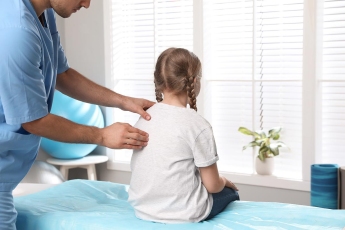Developmental Dysplasia of the Hip
Developmental dysplasia of the hip (DDH) is one of the more common disorders found in infants and young children due to improper development of the hip joint. In the United States, 1-2 out of 1,000 babies born will have DDH. This can happen while the fetus is in the uterus or during development during the child's first year of life. It mostly affects girls and can be mild or severe, affecting one or both hips.
The hip is a ball-and-socket joint, in children with DDH, the hip joint does not form normally causing the ball to be loose in the socket, leading to easy dislocation. The socket is shallow meaning the ball of the femur cannot firmly fit into the socket. The ligaments may also be too stretched to where they cannot help to hold the joint in place.
There are mild to severe cases of DDH that can be determined by the hip looseness or instability.
- Dislocated: In severe cases the ball of the femur is completely out of the socket.
- Dislocatable: In these cases the ball lies within the socket, but can easily be pushed out.
- Subluxatable: In mild cases, the ball is loose in the socket and can be moved within the socket but it will not dislocate.
Causes
- Predominant in girls
- Firstborn children
- Babies born in breech
- Family history
- Abnormal position of the femoral head
- Acetabulum that is too shallow or sloping acetabulum
- Looseness of joint ligaments
- Swaddling or wrapping of the baby in which both of their legs are tied together and extended out straight
Symptoms
- Different length in legs
- Uneven skin folds in thigh area
- Less mobility or flexibility
- Limping, toe walking or waddling
Reproduced with permission from OrthoInfo. © American Academy of Orthopaedic Surgeons. https://orthoinfo.org/
Making a Diagnosis
Developmental dysplasia of the hip does not cause pain so you may not notice the condition until your child starts to walk. Children with developmental dysplasia of the hip may walk with a limp or a waddle.
Appropriate newborn and infant screenings (e.g., ultrasounds, x-rays, Ortolani’s maneuver, or Barlow’s test for infants and Galeazzi’s test for infants over three months) are tools for early detection, which is especially essential if your child was born by breech or if you have a family history of developmental dysplasia of the hip. Your doctor will screen for DDH at your newborn's first exam and every well-being check after.
Treatment Options
The treatment your child will receive after a diagnosis of developmental dysplasia of the hip will depend on their age and how severe their condition is. DDH can typically bee corrected with a harness or brace. DDH may go unnoticed if the hip is not dislocated at birth. If it goes unnoticed until the child begins walking, the treatment can be more complicated.
Nonsurgical Treatment
A harness or similar device will be used depending on age. They are typically worn full-time for six weeks, and then part-time for another six weeks. An abduction brace or brace made of firmer material may be used if the hip does not stay in place with the harness.
- Newborns: A Pavlik harness is used for one to two months. The baby is placed in this soft positioning device to keep the thighbone in the socket.
- One to Six Months: Similar to new born treatment, the thighbone is repositioned with a harness.
- Six Months to Two Years: Treated with closed reduction and spica casting.
Surgical Treatment
A closed reduction procedure may be required if the harness or brace does not work.
- Six Months to Two Years: If closed reduction is not successful, open surgery is necessary.
- Older than Two: As the child grows, looseness can worsen, open surgery is necessary.
Outcomes
When DDH is diagnosed and treated successfully early, the child should develop a normal hip joint and normal function. Leaving DDH untreated can cause pain and osteoarthritis in early adulthood. Different leg length and agility can also be affected.




